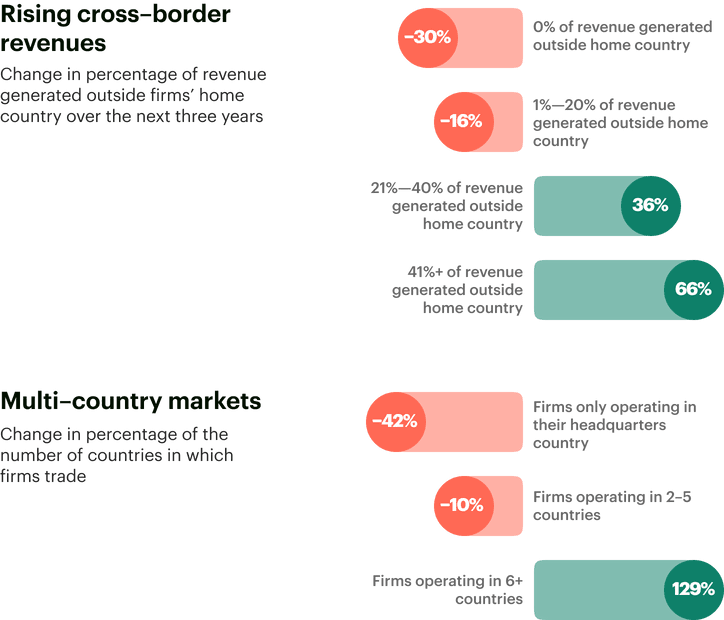SMEs are Getting Global
The life cycle of a business used to be: grow, become big, become bigger than big, then take over the world. Now, world-conquering comes first. And you don’t have to be big to do that.
The obsolescence of borders
If you were starting a business some 100 years ago, you’d have to wait a really long time to become international. You’d first establish your dominance in the local market, becoming so big you had nowhere else to grow than abroad. It used to take decades to make that leap.

Source: The Global SME Mindset by SAP and Global Economics
Today, however, trading internationally is not only easy - it’s the surest way for a small company to grow. As of 2020, 21% of small and 33% of medium enterprises engage in the international trade. Three years from now these numbers are projected to grow even further, ensuring two thirds of all SMEs - small and medium enterprises - generate over 40% of their revenue outside of their home country.
It’s not to say that international markets offer some kind of promised land, with richer customers or lower barriers. On the contrary, global competition makes a tough challenge, and 27% of SMEs recognise it has the greatest impact on their business today. Everyone going global pushes everyone to go global, so many players are forced to enter the market so as not to lose in the game. Yet demanding as it is, there are rich fruits to be plucked from this tree, and SMEs are reaching them faster.

Source: The Global SME Mindset by SAP and Global Economics
Winning against the big guys
The SMEs are not only mimicking, but also beating the multinationals. They have something the big guys lack - agility and speed. With their smaller teams and swifter reactions, SMEs are positioned perfectly to act fast - and to consolidate efforts to take over new markets. These skills are core for establishing market presence in the next few years. The Covid crisis has exposed companies' ability to adapt and pivot fast. Those who passed the test, creating sustainable models and switching between strategies early on, enjoyed months of customer satisfaction.
SMEs are also easier to like. 52% of consumers said they perceive small, up-and-coming challenger brands as more trustworthy than national brands. Small companies are often more personal and sometimes more disruptive than the traditional ones, creating a lasting brand impression and making customers fall in love.
SME community
There are not only customers to be found across the borders. 55% of companies benefit from the network of partners located elsewhere. This includes both suppliers and vendors as well online businesses platforms and networks. The share is even bigger for larger and more profitable companies, suggesting that international relations have contributed to their success. Indeed, if you don’t have to limit yourself to local providers, the choice grows manifold, enabling better deals and fairer competition.

Source: The Global SME Mindset by SAP and Global Economics
This flexible global network of SMEs servicing other SMEs creates a thriving community. The industry to lead SME global expansion was e-commerce, and the first thing they needed to get abroad was manufacturing. But then more complexity arrived. When you are operating in 6-7 different markets, you can’t deal with old school meetings, paperwork, or rigid office hours. So the digital service providers emerged, ensuring same level support in different time zones and online documents exchange. Challenger banks supported financing in new regions. Marketing and PR agencies adjusted to cover several countries' releases.
Growing pains
Global SMEs seem to enjoy unrestrained growth. But what challenges will they need to tackle in the next few years?
The biggest issue many are facing is the intricacy of supply chains. Over 52% admit that supply chain management is key to their future success. As you add more countries to your portfolio, organising manufacturing, storage, and distribution becomes a no simple matter.
So it makes sense that they name business management software as their top investment priority. No longer can a small or medium sized business run on guesstimates and post-its. In order to deliver great service, you need a reliable system under the hood. Without the technological foundation you can’t become a part of this new ecosystem.
The future belongs to SMEs
Over the next 3-5 years, every second business everywhere will be international - and better for it. Global SMEs have become a formidable economic force that drives innovation & competition. They are fast, likeable, and quite successful in competing against the multinationals. They have created an ecosystem that supports itself, ensuring more small and medium businesses thrive by servicing the SMEs. Their next challenge is to tackle business management and supply chain. As they solve this issue, they are sure to have inspired a new tech wave of smarter solutions and better business practices for everybody.

